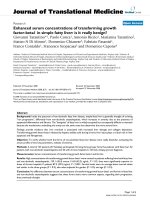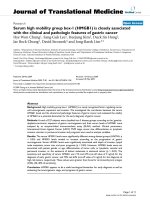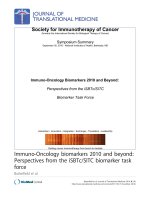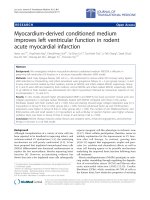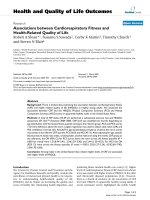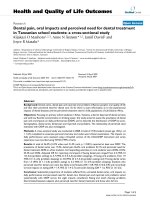Báo cáo hóa học: " EQ-5D visual analog scale and utility index values in individuals with diabetes and at risk for diabetes: Findings from the Study to Help Improve Early evaluation and management of risk factors Leading to Diabetes (SHIELD)" potx
Bạn đang xem bản rút gọn của tài liệu. Xem và tải ngay bản đầy đủ của tài liệu tại đây (250.86 KB, 7 trang )
BioMed Central
Page 1 of 7
(page number not for citation purposes)
Health and Quality of Life
Open Access
Research
EQ-5D visual analog scale and utility index values in individuals with
diabetes and at risk for diabetes: Findings from the Study to Help
Improve Early evaluation and management of risk factors Leading
to Diabetes (SHIELD)
Susan Grandy
1
and Kathleen M Fox*
2
Address:
1
Health Economics and Outcomes Research, AstraZeneca Pharmaceuticals LP, Wilmington, DE, USA and
2
Strategic Healthcare Solutions,
LLC, Monkton, MD, USA
Email: Susan Grandy - ; Kathleen M Fox* -
* Corresponding author
Abstract
Background: The EQ-5D was used to compare burden experienced by respondents with
diabetes and those at risk for diabetes.
Methods: A survey including the EQ-5D was mailed to individuals with self-reported diabetes, as
well as those without diabetes but with the following risk factors (RFs): (1) abdominal obesity, (2)
body mass index ≥ 28 kg/m
2
, (3) dyslipidemia, (4) hypertension, and (5) cardiovascular disease.
Non-diabetes respondents were combined into 0–2 RFs and 3–5 RFs. Mean EQ-5D scores were
compared across groups using analysis of variance. Multivariable linear regression modeling
identified factors affecting respondents' EQ-5D scores.
Results: Complete responses were available from >75% of each cohort. Mean EQ-5D index
scores were significantly lower for respondents with type 2 diabetes and 3–5 RFs (0.778 and 0.792,
respectively) than for those with 0–2 RFs (0.870, p < 0.001 for each); score for respondents with
type 2 diabetes was also significantly lower than for those with 3–5 RFs (p < 0.001). Similar patterns
were seen for visual analog scale (VAS). For both VAS and index scores, after adjusting for other
characteristics, respondents reported decreasing EQ-5D scores as status moved from low to high
risk (-6.49 for VAS score and -0.045 for index score) to a diagnosis of type 2 diabetes (-9.75 for
VAS score and -0.054 for index score; p < 0.001 vs. 0–2 RFs for all).
Conclusion: High-risk and type 2 diabetes groups had similar EQ-5D scores, and both were
substantially lower than in low-risk respondents.
Introduction
It has been estimated that diabetes mellitus affects
approximately 21 million people in the U.S. [1]. Compli-
cations from diabetes include blindness, kidney disease,
nerve damage, arterial disease, abnormal cholesterol lev-
els, hypertension, heart disease, and stroke. Heart disease
and stroke account for 65% of deaths in patients with dia-
betes, with a death rate 2–4 times higher than in adults
without diabetes [2]. Diabetes is the fifth leading cause of
mortality in the U.S., and is associated with increasing
Published: 27 February 2008
Health and Quality of Life Outcomes 2008, 6:18 doi:10.1186/1477-7525-6-18
Received: 14 August 2007
Accepted: 27 February 2008
This article is available from: />© 2008 Grandy and Fox; licensee BioMed Central Ltd.
This is an Open Access article distributed under the terms of the Creative Commons Attribution License ( />),
which permits unrestricted use, distribution, and reproduction in any medium, provided the original work is properly cited.
Health and Quality of Life Outcomes 2008, 6:18 />Page 2 of 7
(page number not for citation purposes)
economic burden, estimated at $132 billion in 2002, up
from $98 billion in 1997 [3].
Diabetes and its complications and comorbidities sub-
stantially affect patients' health-related quality of life
(HRQoL) [4-7]. The impact of treatment, complications,
and comorbidities has been documented to adversely
affect HRQoL among individuals with type 2 diabetes
mellitus [8]. Yet, there is little information on HRQoL
among individuals who do not have diabetes but are at
risk for diabetes. While several disease-specific instru-
ments have been used to measure the HRQoL of patients
with diabetes, there is a need for generic HRQoL measures
as well, to allow comparisons with populations without
diabetes. In particular, such measures can be used to com-
pare the incremental burden experienced by patients with
diabetes and those without diabetes but with similar
comorbidities and risk factors.
A frequently used generic HRQoL instrument is the Euro-
QoL EQ-5D [9]. The objective of this investigation was to
compare EQ-5D scores of individuals diagnosed with dia-
betes and those with varying levels of cardiometabolic
risk, using data from the Study to Help Improve Early
evaluation and management of risk factors Leading to
Diabetes (SHIELD). This investigation will ascertain
whether the burden of having risk factors for diabetes
impacts HRQoL in a similar way as having diabetes.
SHIELD is a 5-year longitudinal survey-based study that is
being conducted to better understand the overall burden
of illness of people living with diabetes as well as those at
risk for its development.
Methods
A 12-item general population screening questionnaire
was used to identify individuals with a diagnosis of diabe-
tes and those with risk factors associated with a diagnosis
of diabetes. In 2004, the screening survey was mailed to a
stratified random sample of 200,000 U.S. households
[10]. This was followed by a baseline survey in which a
sample of identified cases were followed up with a more
detailed survey assessing each individual's health status,
health knowledge and attitudes, and current health-
related behaviors and treatments. A total of 22,001 base-
line survey questionnaires were mailed in late 2004.
Respondents freely volunteered to complete the survey
without enticement, and no IRB approval was required.
Risk factors
In addition to self-reported diagnosis of diabetes,
responses to the screening questionnaire were used to
identify respondents with the following risk factors: (1)
abdominal obesity (waist circumference: men >97 cm,
women >89 cm), (2) body mass index (BMI) ≥ 28 kg/m
2
,
(3) dyslipidemia (reported diagnosis of cholesterol prob-
lems of any type), (4) hypertension (reported diagnosis of
high blood pressure), and (5) history of cardiovascular
disease (reported heart disease/myocardial infarction,
narrow or blocked arteries, stroke, coronary artery bypass
graft surgery, angioplasty, stents, and/or surgery to clear
arteries). These risk factors were derived from the litera-
ture, national guidelines, and expert opinion as modifia-
ble or treatable risk factors for the future development
and/or diagnosis of diabetes [11,12]. Respondents with
0–2 risk factors were classified as low risk and those with
3–5 risk factors were grouped as high risk for a diagnosis
of diabetes. This paper will focus on respondents with
type 2 diabetes, low risk (0–2 risk factors), and high risk
(3–5 risk factors).
EQ-5D
The EQ-5D was used as a measure of respondents' HRQoL
and utility values. The EQ-5D provides a simple descrip-
tive profile and a single index value for health status
[9,13]. The EQ-5D self-reported questionnaire includes a
visual analog scale (VAS), which records the respondent's
self-rated health status on a graduated (0–100) scale, with
higher scores for higher HRQoL. It also includes the EQ-
5D descriptive system, which comprises 5 dimensions of
health: mobility, self-care, usual activities, pain/discom-
fort, and anxiety/depression. The VAS provides a direct
valuation of the respondent's current state of health,
whereas the descriptive system can be used as a health
profile or converted into an index score representing a von
Neumann-Morgenstern utility value for current health
[9]. The level of problem reported on each of the EQ-5D
dimensions determines a unique health state. Health
states are converted into a weighted health state index by
applying scores from the EQ-5D preference weights elic-
ited from general population samples. These weights lie
on a scale on which full health has a value of 1 and dead
a value of 0. For this study, U.S. population weights were
used to convert to an EQ-5D index score [14].
Statistical analysis
For each group (type 2 diabetes, high risk and low risk),
the mean EQ-5D scores both overall and by dimension
are reported. Statistical comparisons across groups (with
emphasis on comparisons between the type 2 diabetes
group and the other groups) were performed using analy-
sis of variance with Fisher's least significant difference
post-hoc testing, with p < 0.01 considered significant.
In addition, multivariable linear regression modeling was
used to identify those factors that most affected respond-
ents' EQ-5D scores, including the diabetes risk group
(type 2 diabetes, high risk or low risk). Even though the
EQ-5D is a 5-item scale, linear regression modeling has
been used in previous HRQoL studies. These investiga-
tions have demonstrated the comparability of EQ-5D
Health and Quality of Life Outcomes 2008, 6:18 />Page 3 of 7
(page number not for citation purposes)
with other generic HRQoL instruments and its usefulness
in identifying determinants of health states [15-17]. The
following sociodemographic factors were included: age,
gender, race, geographic region, household income and
size, BMI category, and group status (low risk, high risk, or
type 2 diabetes) to determine if diabetes risk was inde-
pendently associated with HRQoL after adjusting for the
sociodemographic characteristics as well as assessing if the
sociodemographic factors were independently associated
with HRQoL. The sociodemographic categories are those
used by the U.S. Census Bureau to describe the U.S. pop-
ulation and are utilized in SHIELD to demonstrate the
representativeness of the study sample. Reference catego-
ries were selected as the largest group except for income
(highest category) and diabetes risk status (type 2 diabe-
tes). Using the methodology of Cavrini and associates and
Sitoh and colleagues [18,19], an ordinal variable for the
EQ-5D index was created by categorizing the continuous
variable into 4 levels, and an ordered logit regression
model was used to confirm the multivariate linear regres-
sion. Results were similar between the linear and ordered
regressions, so the linear regression results were presented
since this statistical technique is more widely used.
Results
Of the 22,001 baseline survey questionnaires mailed,
17,640 were returned (response rate: 80.2%). Complete
responses for the EQ-5D were available from >75% of
each cohort (5,639 of 7,403 for low risk, 5,370 of 6,742
for high risk, and 3,849 of 5,000 for type 2 diabetes). The
sociodemographic characteristics of the baseline respond-
ents who completed the EQ-5D in each group are shown
in Table 1. The low- and high-risk groups had a signifi-
cantly greater proportion of respondents who were
younger, white, and had more education and higher
income compared with the type 2 diabetes group, p <
0.01.
VAS state of health
Mean EQ-5D VAS scores were significantly higher for low-
and high-risk respondents (79.6 and 70.4, respectively)
compared with type 2 diabetes respondents (66.8, p <
0.001 for each) (Figure 1). In addition, the mean VAS
score for low-risk respondents was significantly higher
than the mean score for the high-risk group (p < 0.001). A
greater proportion (34.5%) of respondents at low risk for
diabetes rated their current state of health >90 on the VAS,
compared with respondents with type 2 diabetes (13.9%)
or at high risk for diabetes (17.7%).
Utility index scores
The pattern of EQ-5D utility index scores was similar to
that observed for VAS scores (Figure 2). Mean EQ-5D
index scores were significantly higher for low- and high-
risk respondents (0.870 and 0.792, respectively) than for
those with type 2 diabetes (0.778, p < 0.001 for each). The
mean index score for low-risk respondents was signifi-
cantly higher than the mean for the high-risk group (p <
0.001).
EQ-5D dimensions
Examination of each of the 5 dimensions of the EQ-5D
showed similar rating scores for the type 2 diabetes and
high-risk groups, with both groups more likely to report
more difficulties or limitations compared with the low-
risk group (Table 2). A much higher proportion of
respondents with type 2 diabetes (47.9%) and those at
high risk (43.4%) reported having mobility problems
compared with those at low risk (17.1%) (p < 0.001 for
both) (Table 2). Percentages of respondents reporting
problems with self-care were generally low across all
groups; however, respondents with type 2 diabetes (8.5%)
or at high risk (6.5%) were more likely to report this prob-
lem compared with those at low risk (2.7%). More than
twice as many respondents with type 2 diabetes (36.1%)
and those at high risk (33.3%) reported having problems
performing usual activities compared with those at low
risk (15.7%) (p < 0.001). More respondents with type 2
Table 1: Characteristics of SHIELD baseline respondents who completed the EQ-5D, by group
Characteristics Low Risk n = 5,639 High Risk n = 5,370 Type 2 Diabetes n = 3,849
Age, mean, yrs (SD) 47.0 (16.4)* 58.9 (14.6)* 60.3 (13.1)
Women, % 65.5%* 56.6% 57.8%
Race, % white 88.3%* 88.4%* 85.0%
Education, % with some college or higher 74.0%* 67.3%* 63.9%
Income, % with <$40,000/year 36.5%* 46.3%* 52.5%
Geographic region, %
Northeast 18.8% 19.7% 19.9%
South 34.2% 36.7% 38.5%
Midwest 25.5% 25.5% 23.5%
West 21.4% 18.1% 18.0%
* p < 0.01 for comparison with type 2 diabetes
Health and Quality of Life Outcomes 2008, 6:18 />Page 4 of 7
(page number not for citation purposes)
diabetes (61.1%) and at high risk (61.8%) reported expe-
riencing some pain or discomfort compared with those at
low risk (43.5%) (p < 0.001). Additionally, a greater pro-
portion of those with type 2 diabetes (10.5%) and those
at high risk (9.4%) reported extreme pain or discomfort
compared with low-risk respondents (4.2%) (p < 0.001).
The proportion of respondents reporting moderate levels
of anxiety or depression was similar across respondents
with type 2 diabetes (26.1%) and at high risk (24.9%),
and lowest in respondents at low risk for diabetes
(19.9%).
Multivariable linear regression models
Diabetes risk status was significantly associated with
HRQoL after adjusting for sociodemographic factors
(Table 3). Compared with type 2 diabetes respondents,
the low-risk respondents (9.02 for VAS score and 0.049
for index score; p < 0.0001) and high-risk respondents
(3.18 for VAS score and 0.009 for index score; p = 0.008)
reported higher EQ-5D scores. The model F statistic was
94.0 for VAS score and 83.6 for index score, and the model
r-square was 0.16 for VAS score and 0.15 for index score.
Other sociodemographic characteristics were significantly
associated with EQ-5D scores upon adjusting for diabetes
risk status, including age, income, obesity, gender, race,
geographic region, and household size (Table 3). Increas-
ing age was associated with decreased quality of life for
EQ-5D index scores, although not for VAS scores.
Respondents aged 55–64 years or 75 years and older
reported the greatest negative impact on quality of life (p
< 0.001 vs. respondents aged 35–44 years), with those
aged 18–24 years having the highest EQ-5D scores. The
analysis of VAS scores for current health state showed no
clear trend across age groups compared with respondents
aged 35–44 years. For both VAS and index scores,
respondents' HRQoL decreased as household incomes
decreased; those with incomes <$22,500 reported the
greatest negative impact on HRQoL (p < 0.001 vs.
≥$90,000 in both models).
For both EQ-5D scores, obesity (BMI ≥ 28 kg/m
2
) was
associated with significantly lower HRQoL (p < 0.0001),
while black race was associated with significantly higher
HRQoL compared with white race (p < 0.05) (Table 3).
The results for other sociodemographic factors indicate
that female gender and household size of 3 or ≥5 were
associated with a negative impact on EQ-5D VAS scores,
and female gender and a household size ≥2 were associ-
ated with a negative impact on EQ-5D index scores.
HRQoL was significantly higher among residents of other
geographic regions compared with the Pacific region for
both EQ-5D scores.
Mean EQ-5D VAS scores by groupFigure 1
Mean EQ-5D VAS scores by group. *p < 0.001, low risk
versus T2D and low risk versus high risk. **p < 0.001, high
risk versus T2D. EQ-5D = EuroQoL- 5 Dimensions; T2D =
type 2 diabetes.
79.6
70.4
66.8
0
20
40
60
80
100
120
V
A
S
S
c
o
r
e
EQ-5D Visual Analog Scale Current State of Health
Lo w r i sk Hi gh ri sk T2D
*
*
**
Mean EQ-5D utility index scores by groupFigure 2
Mean EQ-5D utility index scores by group. *p < 0.001,
low risk versus T2D and low risk versus high risk. **p <
0.001, high risk versus T2D. EQ-5D = EuroQoL- 5 Dimen-
sions; T2D = type 2 diabetes.
0.870
0.792
0.778
0.000
0.200
0.400
0.600
0.800
1.000
1.200
I
n
d
e
x
S
c
o
r
e
EQ-5D Utility Index
Lo w r i sk High r isk T2D
*
*
**
Table 2: Proportion of respondents reporting problems on each EQ-5D dimension in the baseline SHIELD survey, by group
Proportion of respondents reporting some or unable, or moderately/extremely, % Low risk High risk Type 2 Diabetes
Decreased mobility 17.1*^ 43.4* 47.9
Difficulty with self-care 2.7*^ 6.5* 8.5
Problems performing usual activities 15.7*^ 33.3* 36.1
Pain or discomfort 43.5*^ 61.8 61.1
Anxious or depressed 19.9*^ 24.9 26.1
EQ-5D = EuroQoL-5 Dimensions; *p < 0.001 for comparison with type 2 diabetes; ^ p < 0.0001 for comparison of high risk to low risk
Health and Quality of Life Outcomes 2008, 6:18 />Page 5 of 7
(page number not for citation purposes)
Discussion
The EQ-5D results from the SHIELD survey demonstrate
that respondents at low risk for the development and
diagnosis of diabetes experienced the lowest proportion
of self-reported difficulties in all 5 measured dimensions
(mobility, self-care, usual activities, pain/discomfort, and
anxiety/depression) compared with respondents with
type 2 diabetes or at high cardiometabolic risk. Overall
EQ-5D scores, whether measured by VAS or index score,
were substantially higher in the low-risk group compared
with the high-risk and type 2 diabetes groups, even after
adjusting for sociodemographic characteristics. The high-
Table 3: Multivariable linear regression analyses of factors impacting EQ-5D scores in SHIELD baseline respondents*
Variables EQ-5D VAS score n = 14,383 EQ-5D index score n = 14,378
Beta coefficient SE Beta coefficient SE
Diabetes risk group
Low risk 9.02† 0.45 0.049† 0.004
High risk 3.18† 0.39 0.009† 0.004
Type 2 diabetes (reference) (reference)
Age (yrs)
18–24 5.69† 0.94 0.052† 0.008
25–34 0.39 0.63 0.011 0.006
35–44 (reference) (reference)
45–54 - 0.65 0.51 - 0.025† 0.005
55–64 - 0.34 0.54 - 0.033† 0.005
65–74 2.82† 0.58 - 0.011† 0.005
≥75 - 0.45 0.64 - 0.031† 0.006
Gender
Female - 1.16† 0.32 - 0.029† 0.003
Male (reference) (reference)
Race
White (reference) (reference)
Black 1.20† 0.59 0.014† 0.005
Other - 1.66 0.96 - 0.015 0.009
Household Income ($) per year
<22,500 - 13.03† 0.49 - 0.121† 0.004
22,500–39,999 - 6.68† 0.49 - 0.066† 0.004
40,000–59,999 - 3.62† 0.50 - 0.037† 0.004
60,000–89,999 - 1.71† 0.49 - 0.020† 0.004
≥90,000 (reference) (reference)
Geographic region
Northeast 2.70† 0.80 0.029† 0.007
Middle Atlantic 2.34† 0.58 0.026† 0.005
East North Central 2.28† 0.56 0.021† 0.005
West North Central 2.58† 0.70 0.023† 0.006
South Atlantic 1.87† 0.54 0.015† 0.005
East South Central 0.42 0.73 - 0.002 0.007
West South Central 1.75† 0.63 0.014† 0.006
Mountain 1.03 0.74 0.011 0.007
Pacific (reference) (reference)
Household size (no. of members)
1 (reference) (reference)
2 - 0.77 0.43 - 0.009† 0.004
3 - 1.68† 0.53 - 0.018† 0.005
4 - 1.05 0.59 - 0.010† 0.005
≥5 - 2.52† 0.64 - 0.022† 0.006
Body mass index (kg/m
2
) group
Underweight - 3.12† 1.43 - 0.017 0.013
Normal weight (reference) (reference)
Overweight - 1.33† 0.46 - 0.007 0.004
Obese - 6.57† 0.47 - 0.047† 0.004
*Scores indicate change from reference group. †p < 0.05 versus reference group
EQ-5D = EuroQoL-5 Dimensions; VAS = visual analog scale; SE = standard error
Health and Quality of Life Outcomes 2008, 6:18 />Page 6 of 7
(page number not for citation purposes)
risk and type 2 diabetes groups had similar health profiles
and overall scores, although the latter reported somewhat
lower overall HRQoL.
Respondents with type 2 diabetes reported the highest
rates of difficulties with mobility, self-care, and perform-
ing usual activities. Similar proportions (> 60%) of
respondents with type 2 diabetes and at high risk for dia-
betes reported experiencing some pain or discomfort.
Reported rates of moderate anxiety or depression were
also similar for respondents with type 2 diabetes and
those at high risk. These findings were similar to other
studies, which found impaired physical and social func-
tioning as measured by the SF-36 among individuals with
type 2 diabetes [20,21].
This study provides evidence of the HRQoL of respond-
ents at risk for diabetes as well as those with type 2 diabe-
tes using a generic HRQoL instrument. The EQ-5D in the
present study allowed for comparisons of respondents not
yet diagnosed with diabetes since the dimensions were
relevant to overall well-being. Other studies have typically
compared type 2 diabetes patients with the general popu-
lation [20-22]. Studies using the Medical Expenditure
Panel survey (MEPS) examined individual risk factors and
a cluster of similar cardiometabolic risk factors (BMI ≥25
or ≥30 kg/m
2
, hyperlipidemia, hypertension and diabe-
tes) as used in the present study and found a similar sig-
nificant deleterious impact on HRQoL as measured by the
EQ-5D and SF-36 [22,24].
Construct validity of the EQ-5D has been established in
several chronic diseases, including rheumatoid arthritis
[25,26], stroke [27], and AIDS [28]. However, it has not
been widely used in diabetes studies, where preference is
to use the various disease-specific HRQoL instruments.
Yet, the EQ-5D is a valid measure of HRQoL with modest
correlation with measures of impairment (e.g., joint
scores, HIV scales) and high correlation with patients' per-
ception of their disabilities (e.g., Health Assessment Ques-
tionnaire, Barthel Index, and Modified Rankin scale)
[25,27,28]. The EQ-5D has performed equally well when
compared with other generic HRQoL and utility-based
instruments, including the Health Utilities Index Mark 2
and 3 and SF-6D [26,29].
In the present study, no clear trend in the EQ-5D VAS
scores across age groups was observed, even though there
was a strong age association in the EQ-5D index score. In
rheumatoid arthritis, Hurst and colleagues [25] found a
negative association with age for both the utility and VAS
scores; yet Hart and colleagues [17] found no age associa-
tion among patients with type 1 diabetes mellitus. It is
unclear in the present study why current health status
(VAS) was reported as better in 65-74-year-old respond-
ents compared with 35-44-year-old respondents.
The EQ-5D utility scores from this study provide a prefer-
ence-based score that can be used to calculate quality-
adjusted life years for future cost-effectiveness analyses of
treatment or prevention of diabetes and evaluating
healthcare interventions both clinically and economi-
cally. Since SHIELD respondents are representative of the
U.S. population with or at risk for diabetes, the EQ-5D
utility scores would be useful for national and multi-
national comparisons for quality-adjusted life-year assess-
ments.
The present study provides evidence of the impact of type
2 diabetes and high risk on HRQoL in a large sample with
a high survey response rate. Moreover, the respondents
are representative of the U.S. population, and the evalua-
tion of HRQoL was done using a standardized, validated
measure so that norm-based results are provided. How-
ever, it should be noted that household panels such as
those used for this survey tend to under-represent the very
wealthy and very poor segments of the population, and
do not include military or institutionalized individuals. In
addition, SHIELD relied only on self-reported data to
identify samples of respondents, without clinical or labo-
ratory confirmation. These limitations are the same for
most survey-based methodologies.
Conclusion
The EQ-5D results from the SHIELD survey show that
respondents with type 2 diabetes and those at high risk for
future diagnosis of diabetes report decreased overall
HRQoL and more difficulty with mobility, self-care, and
usual activities compared with those at lower risk.
Reported reductions in HRQoL may be due to related
comorbidities or to overall health burden. Reducing cardi-
ometabolic risk factors may lead to significant improve-
ments in HRQoL even before diabetes is diagnosed in
high-risk respondents. Respondents with a low risk for
diabetes consistently reported the lowest rates of prob-
lems or difficulties across all 5 health dimensions meas-
ured by the EQ-5D. Further follow-up is needed to track
HRQoL profiles over time, as those who are at risk for dia-
betes are diagnosed and learn to cope with their disease.
Abbreviations
BMI – Body mass index; EQ-5D – EuroQoL-5 Dimen-
sions; HRQoL – Health-related quality of life; RF – Risk
factor; SHIELD – Study to Help Improve Early evaluation
and management of risk factors Leading to Diabetes; U.S.
– United States; VAS – Visual analog scale
Health and Quality of Life Outcomes 2008, 6:18 />Page 7 of 7
(page number not for citation purposes)
Competing interests
SHIELD, the SHIELD Study Group, and the preparation of
this manuscript were supported by funding from Astra-
Zeneca LP. Dr. Susan Grandy is an employee of Astra-
Zeneca LP, and Dr. Fox is a research consultant for
AstraZeneca LP.
Authors' contributions
SG participated in the conception, design and coordina-
tion of the SHIELD study and helped to draft the manu-
script. KF performed the statistical analysis and drafted the
manuscript. All authors read and approved the final man-
uscript.
Acknowledgements
The SHIELD Study Group includes the following individuals: Harold E. Bays,
MD (chair), Debbra D. Bazata, RD, LD, MA, Nathaniel G. Clark, MD,
Andrew J. Green, MD, Sandra J. Lewis, MD, Helena Rodbard, MD, Michael
L. Reed, PhD, and Walter Stewart, PhD. The following individuals also con-
tributed to the work reported in this manuscript: Richard Chapman (anal-
ysis and manuscript drafting) of ValueMedics Research; and Tina Fanning
(data collection and analysis) of Vedanta Research. This study was pre-
sented as a poster at the ISPOR 12
th
Annual International Meeting, Arling-
ton, VA, May 19–23, 2007.
References
1. Centers for Disease Control and Prevention: National diabetes
fact sheet: general information and national estimates on
diabetes in the United States, 2005. Atlanta, GA: U.S. Department
of Health and Human Services, Centers for Disease Control and Prevention
2005.
2. American Diabetes Association: Complication of diabetes in the
United States. [ />plications.jsp]. Accessed May 4, 2007
3. Thom T, Haase N, Rosamond W, Howard VJ, Rumsfeld J, Manolio T,
Zheng ZJ, Flegal K, O'Donnell C, Kittner S, Lloyd-Jones D, Goff DC
Jr, Hong Y, Adams R, Friday G, Furie K, Gorelick P, Kissela B, Marler
J, Meigs J, Roger V, Sidney S, Sorlie P, Steinberger J, Wasserthiel-
Smoller S, Wilson M, Wolf P, American Heart Association Statistics
Committee and Stroke Statistics Subcommittee: Heart disease and
stroke statistics – 2006 update: a report from the American
Heart Association Statistics Committee and Stroke Statis-
tics Subcommitee. Circulation 2006, 113:e85-e151.
4. Luscombe FA: Health-related quality of life measurement in
type 2 diabetes. Value Health 2000, 3(Suppl 1):15-28.
5. Garratt AM, Schmidt L, Fitzpatrick R: Patient-assisted health out-
come measures for diabetes: A structured review. Diabet Med
2002, 19:1-11.
6. Watkins K, Connell CM: Measurement of health-related QOL
in diabetes mellitus. Pharmacoeconomics 2004, 22:1109-1126.
7. Centers for Disease Control and Prevention: Self-rated fair or
poor health among adults with diabetes – United States,
1996–2005. MMWR 2006, 55:1224-1227.
8. Anderson RM, Fitzgerald JT, Wisdom K, Davis WK, Hiss RG: A com-
parison of global versus disease-specific quality-of-life meas-
ures in patients with NIDDM. Diabetes Care 1997, 20:299-305.
9. Rabin R, de Charro F: EQ-5D: a measure of health status from
the EuroQol Group. Ann Med 2001, 33:337-343.
10. Bays HE, Chapman RH, Grandy S, the SHIELD Investigators' Group:
The relationship of body mass index to diabetes mellitus,
hypertension and dyslipidaemia: comparison of data from
two national surveys. Int J Clin Pract 2007, 61:737-747.
11. American Diabetes Association: Standards of Medical Care in
Diabetes – 2007. Diabetes Care 2007, 30(Suppl 1):S4-S41.
12. National Cholesterol Education Panel (NCEP); National Heart, Lung
and Blood Institute: Detection, evaluation and treatment of
high blood cholesterol in adults (Adult Treatment Panel III).
Final Report. 2002 [ />terol/atp3_rpt.htm]. Accessed May 4, 2007
13. EuroQoL Group: EuroQol – a new facility for the measure-
ment of health-related quality of life. Health Policy 1990,
16:199-208.
14. Shaw JW, Johnson JA, Coons SJ: US valuation of the EQ-5D
health states: Development and testing of the D1 valuation
model. Med Care 2005, 43:203-220.
15. Sapin C, Fantino B, Nowicki M, Kind P: Usefulness of EQ-5D in
assessing health status in primary care patients with major
depressive disorder. Health and Quality of Life Outcomes 2004, 2:20.
16. Kind P, Koltowska-Haggstrom M: Incorporating social prefer-
ences in the measurement of QoL outcomes in growth hor-
mone deficiency (GHD) in adults. Endocrine Abstracts 2004,
7:P147.
17. Hart HE, Redekop WK, Bilo HJG, Meyboom B, Berg M: Health
related quality of life in patients with type I diabetes mellitus:
generic and disease-specific measurement. Indian J Med Res
2007, 125:203-216.
18. Cavrini G, Pacelli B, Pandolfi P, Collina N, Mezzetti F, Pesci P, Perlan-
geli V: A proposal for modeling an EQ-5D index by ordered
regression model. University of Bologna, Italy 2004.
19. Sitoh YY, Lau TC, Zochling J, Schwarz J, Chen JS, March LM, Cumming
RG, Lord SR, Sambrook PN, Cameron ID: Determinants of
health-related quality of life in institutionalized older per-
sons in northern Sydney. Internal Med J 2005, 35:131-134.
20. Hanninen J, Takala J, Keinanen-Kiukaanniemi S: Quality of life in
NIDDM patients assessed with the SF-20 questionnaire. Dia-
betes Res Clin Pract 1998, 42:17-27.
21. Schlotz W, Ambery P, Syddall HE, Crozier SR, Sayer AA, Cooper C,
Phillips DI, Hertfordshire Cohort Study Group: Specific associa-
tions of insulin resistance with impaired health-related qual-
ity of life in the Hertfordshire Cohort Study. Qual Life Res 2007,
16:429-436.
22. Ribu L, Hanestad BR, Moum T, Birkeland K, Rustoen T: A compar-
ison of the health-related quality of life in patients with dia-
betic foot ulcers, with a diabetes group and a nondiabetes
group from the general population.
Qual Life Res 2007,
26:179-189.
23. Sullivan PW, Ghushchyan V, Wyatt HR, Wu EQ, Hill JO: Impact of
cardiometabolic risk factor clusters on health-related quality
of life in the U.S. Obesity 2007, 15:511-521.
24. Sullivan PW, Lawrence WF Jr, Ghushchyan V: A national catalogue
of preference-based scores for chronic conditions in the U.S.
Med Care 2005, 43:736-749.
25. Hurst NP, Kind P, Ruta D, Hunter M, Stubbings A: Measuring
health-related quality of life in rheumatoid arthritis: validity,
responsiveness and reliability of EUROQOL (EQ-5D). Brit J
Rheumatol 1997, 36:551-559.
26. Luo N, Chew LH, Fong KY, Koh DR, Ng SC, Yoon KH, Vasoo S, Li
SC, Thumboo J: A comparison of the EuroQol-5D and the
Health Utilities Index mark 3 in patients with rheumatic dis-
ease. J Rheumatol 2003, 30:2268-2274.
27. Pickard AS, Johnson JA, Feeny DH: Responsiveness of generic
health-related quality of life measures in stroke. Qual Life Res
2005, 14:207-219.
28. Wu AW, Jacobson KL, Frick KD, Clark R, Revicki DA, Freedberg KA,
Scott-Lennox J, Feinberg J: Validity and responsiveness of the
euroqol as a measure of health-related quality of life in peo-
ple enrolled in an AIDS clinical trial. Qual Life Res 2002,
11:273-282.
29. Wee HL, Machlin D, Loke WC, Li SC, Cheung YB, Luo N, Feeny D,
Fong KY, Thumboo J: Assessing differences in utility scores: a
comparison of four widely used preference-based instru-
ments. Value Health 2007, 10:256-265.
